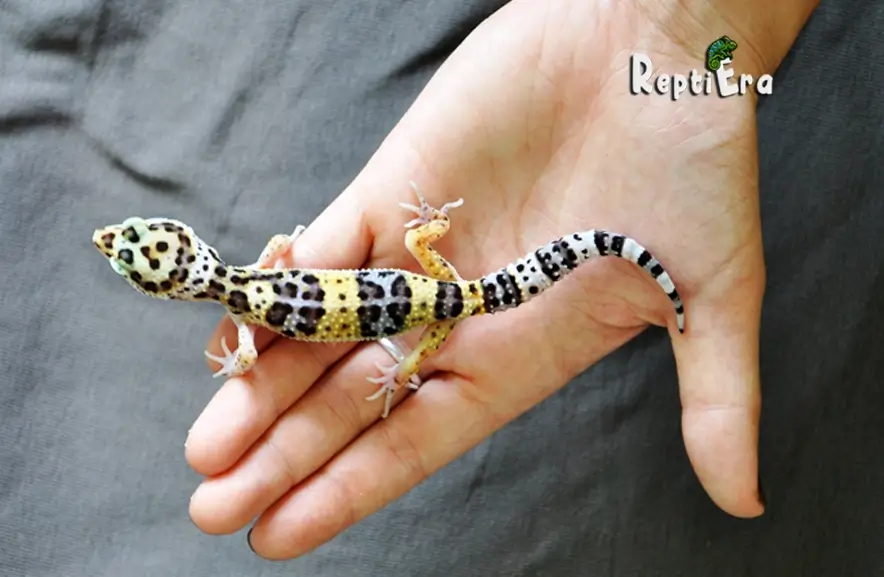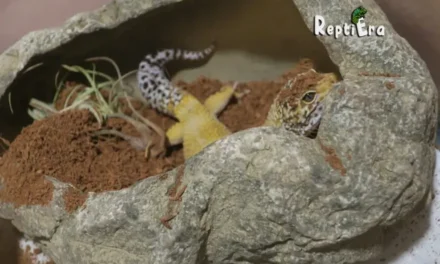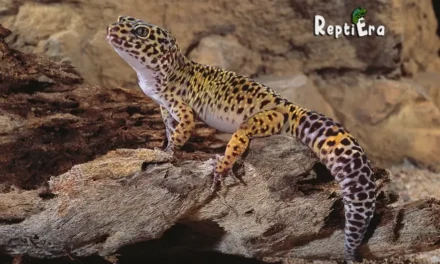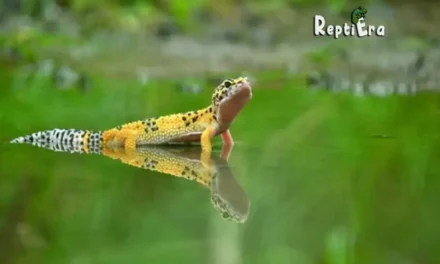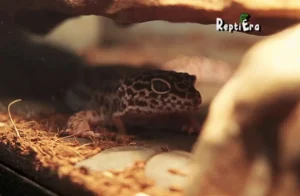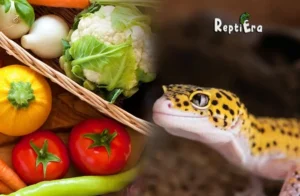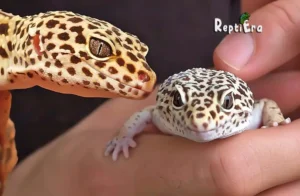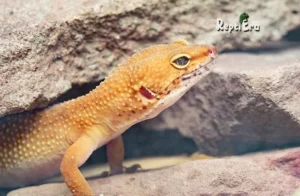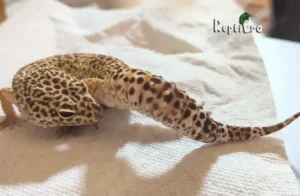Bonding with your leopard gecko can be a unique and rewarding experience, though it plays by different rules compared to mammals. As keepers of these fascinating reptiles, the key is to observe their behaviour and understand their needs within their enclosure.
How To Bond With Your Leopard Gecko?
Establishing a bond with your little Leo is not only about building trust but also about creating a connection that resonates with their natural instincts. Unlike more common pets, leopard geckos require a more straightforward approach to building bonds.
This process involves regular, gentle interaction, allowing them to recognize and become comfortable with your presence. It’s a journey of mutual respect and understanding, where patience and consistent care play a pivotal role in nurturing this unique relationship.
Table of Contents
So How To Bond With Your Leopard Gecko?
In the journey of bonding with a leopard gecko, incorporating best practices of husbandry is paramount. It’s crucial to provide a low-stress environment, both inside and outside the enclosure, to foster a sense of security. Effective handling and feeding techniques, when done consistently, serve as positive reinforcement.
Establishing a regular routine not only aids in reducing stress but also improves the bond over time. Carefully observing and responding to your gecko’s needs creates an environment where they feel safe and understood, deepening the connection between you and your little companion.
To bond more strongly with your leopard gecko, it’s not just about a quick answer; it involves delving into detail. The special tricks and tips I’m about to cover are what you need to know to address the core concept of building bonds.
The set-up for success in this relationship lies in understanding their unique needs and behaviours. For instance, creating a routine and environment that mimics their natural habitat plays a crucial role. Regular, gentle interaction, monitoring their health, and providing the right diet are key elements. Remember, each leopard gecko has its personality; respecting that will enhance your bond significantly.
Positive Reinforcement Is The Foundation Of Bond Building
Positive reinforcement is crucial in shaping the behaviour of leopard geckos. When your gecko climbs a rock in their enclosure, or eagerly appears for a crunchy cricket, these are moments to figure out which behaviours are worth reinforcing. For instance, if climbing often leads to a cricket, the gecko learns that climbing results in a reward. This method of reinforcing behaviours strengthens the bond between you and your gecko.
Imagine your gecko crawling onto your hand or coming to the front of the cage, seeking interaction; these moments, akin to a dog hanging out on your shoulder, highlight the responsive nature of these brainy reptiles. They respond to training over time, much like frogs or even dogs, albeit with a different approach. They’re surprisingly smart and can connect actions to behaviours, especially when a food reward is involved.
Using positive experiences consistently lays the foundation of trust and connection. Your leopard gecko will begin to associate your presence with good things, much like dogs do with treats. This approach not only helps build bonds but also emphasizes that leopard geckos, like many other pets, enjoy and like learning new tricks. They are not so different in their capacity to feel secure and valued through positive interactions and rewards.
Also Read: WHY DOES MY LEOPARD GECKO STARE AT ME
Best Ways To Build A Bond And Get Your Leopard Gecko To Like You
Having grasped the fundamentals of positive reinforcement, let’s explore the specific methods for developing a bond, many of which incorporate aspects of positive reinforcement.
1. Take Care Of Husbandry First
Before building bonds with your leopard gecko, prioritizing their basic needs through proper husbandry is essential. This includes maintaining control over the proper temperatures in the enclosure, ensuring there’s a warm side and a cool side, and providing various hiding spots. Offering enrichment opportunities such as climbing structures and digging areas is vital.
Avoid anthropomorphizing their behaviours; a gecko isn’t cold or tired in human terms, but it might seek shelter for comfort. Making friends with your gecko involves more than just positive reinforcement; it starts with foundational care. The enclosure size matters, with an adequate-sized tank being crucial. Often, a bigger tank is better for your Leo, allowing them more space to explore and feel secure, thereby reducing stress and setting the stage for a stronger, more positive bond.
Below is a concise table to assist you with the appropriate care for your reptile:
| Enclosure size | 1 leo: 36 inches length × 24 inches wide × 12 inches high (60 cm x 60 cm x 30 cm)2 leos: 90 inches length × 24 inches wide × 12 inches high (90 cm x 60 cm x 30 cm) |
| Temperature range | From 68 °F to 89 °F (20 °C to 32 °C) |
| Humidity | Between 30% and 40% |
| Heating sources | A heat mat covering one-third to a half of the enclosure’s floor, or a heat lamp pointed towards some rocks or slate tiles so they can retain heat |
| Substrate | Large pebbles, slate tiles, reptile carpet, paper towels, or newspaper |
| Hiding spots | At least 3, one on the warmer side, one on the cooler side, and one in the middle of the last two. |
2. Create Your Special Sound
One intriguing aspect of bonding with your leopard gecko involves creating a special sound or signature sound. Unlike cats or dogs, lizards like leopard geckos don’t respond to their names, but they can learn to associate certain sounds with positive experiences, like food or treats.
This special sound could be as simple as a click of the tongue against the back of your teeth, or even a series of clicks – a kind of special song for your gecko. It doesn’t need to be complicated; even simple sounds, like gentle snaps or a soft humming, can be effective. The goal is to use this sound consistently, especially when you feed them, to establish a positive association. This method, akin to clicker training used in animals at home, is a form of positive reinforcement that can be both fun and rewarding.
Your leopard gecko’s enclosure is their home, and you want everything that happens there to be a good experience. When you encourage your gecko to come to the front of the cage with a click or your special sound, offering a snack as a reward, you win the trust and strengthen your bond. This building bond is not just about trust, but also about creating a calm environment, even in stressful situations like a foot bath for a stuck-on toe shed or adding water to reduce stress.
By establishing this sound as something positive, you encourage them to see you as a source of good things, thus building bonds and trust. It’s important to ensure that this sound never becomes associated with anything negative to avoid creating a negative association.
3. Allow Your Leo To Get Used To Its New Environment
When introducing a leopard gecko to a new home, it’s common for them to feel stressed due to the change of scenery and the unfamiliarity of an unknown environment. As an owner, you might be excited about setting up a comfy enclosure, but it’s important to remember that for your pet, even what seems insignificant to us can be a huge, stressful shift.
Note: Initially, you may notice your gecko hiding more often, which is a natural response. Give them enough time to acclimate to their surroundings and understand that this new place is a safe place. Usually, it takes about three to four weeks for a gecko to settle in properly. During this time, avoid making unnecessary changes to the enclosure to help your Leo adjust with minimal stress.
4. Allow Your Leo To Get Used To Your Smell
Leopard geckos have the ability to recognize different smells, and they can associate these with either good experiences or bad experiences. When you’re new to them, they might initially feel uneasy. An effective advantage in bonding is letting them get used to your smell. One way to do this is by placing a piece of clothes you wear frequently near their enclosure. This helps your pet learn that nothing bad happens when your scent is around, gradually building trust and familiarity.
5. Announce your presence
In bonding with your leopard gecko, it’s helpful to talk to them or use a particular sound or call that they can get used to. This helps them associate your sound or the tone of your voice with your presence. Being consistent with the same tone or word each time you’re talking to them is crucial, as consistency is key in building trust with these sensitive pets. Incorporating these sounds into your daily handling routine, in small doses, reduces the chance of stress for the animal and helps them become used to it. This method fosters a sense of familiarity and safety each time you approach their enclosure.
6. Respect The Routine And Keep It Crepuscular
Leopard geckos are often mislabeled as nocturnal, but these little lizards are actually crepuscular, being most active during the early morning and evening hours. This behaviour stems from their natural desert habitat, where the temperature is more tolerable at these times.
When in captive care, it’s crucial to respect their instincts. For instance, expecting your gecko to be awake at 1:00 PM is against their sleeping time and can hinder building bonds. Adhering to a consistent schedule or routine for food and handling, preferably at the same time every day, aligns with their natural rhythm. Avoiding the temptation to pull out your gecko at random hours is important, as these creatures prefer their waking up and active times, and deviating from this can cause stress.
7. Minimize Stress When Your Leopard Gecko Is Outside Their Enclosure
When it comes to building bonds with leopard geckos, minimizing stress during their time outside the enclosure is vital. Unlike in the wild, where they naturally explore while being wary of predators like mammals or foxes, in a domestic setting, loud noises, being sniffed by other species, or bright lights can induce stress.
Remember, these reptiles are not used to playing cool in the presence of other animals, and even the most well-meaning interactions with folks or other pets can add to the mix of stressors. Therefore, keeping interactions trust-building and stress-free is key. It might be tempting to let your Leo explore the larger world beyond their tank, but this can often lead to excess stress.
To create bonds while ensuring a positive, stress-free experience, consider using positive reinforcement like food rewards during these outings. This approach helps them associate these interactions with something good, building trust and comfort. However, it’s important to keep these sessions short and always within a safe, controlled environment.
Leos, like many other reptile species, do not require or appreciate tank mates or overly stimulating environments. By carefully managing their environment and reducing their exposure to potential stressors, you reduce the chances of negative experiences, thereby building bonds that are based on security and positive association.
Also Read: HOW TO TRAVEL WITH A LEOPARD GECKO
8. Minimize Stress When Your Leopard Gecko Is Inside Their Enclosure, Too
Minimizing stress for your leopard gecko is just as important inside their enclosure as it is outside. Other pets, like a cat taking a seat on a shelf to watch your little Leo, can be a source of stress. Even subtle changes in their environment, such as fluctuations in temperature caused by fans or direct sunlight, can lead to problems.
Additionally, be mindful of heavy fragrances from candles or incense, as these can cause issues for your sensitive reptile. Keeping the big picture in mind when it comes to creating a comfortable habitat is crucial for bonding. This includes considering all external factors that could impact their well-being.
Using positive reinforcement can sometimes be difficult in these situations, but it’s important to reduce the chances of your gecko feeling worried or stressed. For instance, when your gecko comes to the front of the cage, being greeted with an eager attitude rather than fear of becoming a meal for another animal is essential.
Ensuring that their enclosure is a safe haven, where they can enjoy their meal and relax without stress, plays a significant role in bonding with your leopard gecko.
9. Bribe Your Leo With Treats!
In the first few weeks of bringing a new leopard gecko home, they’re still getting used to their enclosure. One effective method to start bonding is by leaving food in their preferred hiding spot.
As they become more comfortable, you can begin to feed them with tongs or tweezers and eventually attempt to hand-feed. Carefully present their favourite treats—such as crickets, waxworms, or mealworms—to help build a positive relationship. When your Leo successfully hunts and eats from your hand, they start to associate you with feeding time, which can greatly strengthen your bond. However, be cautious not to overfeed; the size of the treat should be no bigger than half the size of their head to prevent choking.
Additionally, you can practice using a special sound or call, as mentioned in the “Get Your Leo To Recognize Your Voice” section of this article, when it’s time to feed them. This practice not only helps in forming a connection but also reinforces the association of your presence with something enjoyable.
Remember, the goal is to make each interaction with your leopard gecko a positive experience, gradually building trust and familiarity in your relationship.
10. Reward your Leopard Gecko with Food
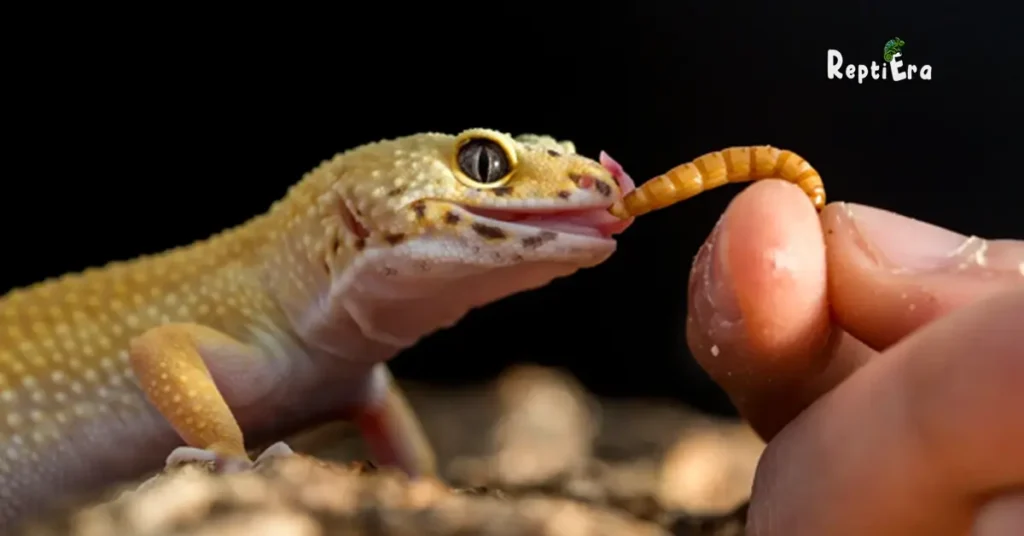
Ensuring your pet geckos feel safe and secure is a fundamental part of bonding, and a full belly can play a significant role in this. Feeding time is not just about nutrition; it’s an opportunity for handling and interaction. When your gecko begins to associate your presence with food, it creates a positive connection.
Whether it’s the sound of the enclosure opening or the tone of your voice at mealtime, these cues help establish a consistent feeding schedule. However, be mindful of overfeeding. Hand feeding by offering insects directly can be a bonding experience. Remember, leopard geckos are steady, graceful hunters. They might occasionally miss and nip or bite by surprise or alarm, especially when handling insects. It’s important not to freak out if bitten; instead, using tongs or tweezers can be a safer method.
When setting up their aquarium, do it with a purpose. Avoid dropping food on the ground as it might disturb their natural stalking and prey-chomping behaviour. Watching a gecko hunt, stalking their prey, and then chomping down on it can be fascinating.
When the prey is swallowed, it’s a sign of a comfortable and content pet. However, be cautious about touching or picking up your gecko during or immediately after feeding, as this can be a sensitive time for them.
Related Post: CAN LEOPARD GECKOS EAT VEGGIES
11. Learn How To Handle Your Leo Safely
Handling your leopard gecko safely is essential for their comfort and your bonding experience. Initially, your gecko might run away as you get closer, but with time, they’ll grow accustomed to your presence. Start by placing your hand inside the enclosure and letting it rest for a few minutes to get relaxed. If they seem bothered, it’s crucial to inspect their behaviour and exhibit patience.
Some geckos are more adventurous and might move towards your hand with eager attention, while others may be less inclined. It’s important to suppress the urge to scoop them up immediately, as this can be counterproductive to the bonding process. Instead, let them lick and sniff your hand, showing they’re comfortable and possibly eager for food.
Practicing patience skills is key. Allow your Leo to climb onto your hand or sniff your arm before attempting to lift them out of the enclosure. The “scooping method” is effective: cup your hand in front of the pet, then gently slide your hand under their forelegs and encourage them to hop on.
Avoid trying to pick up your gecko from the front or side, and never firmly grip their midsection. Once they are secured on your hand, with their body supported by your fingers, you can carefully lift them. If they become squirmy or look like they might fall, use your free hand to support them underneath.
Tips To Handle Your Leo
Here are some tips to enhance the experience of interacting with your pet for both you and your Leo:
- Initiate handling your leopard gecko at an early age, aiding in its acclimatization to human contact, resulting in a calmer and more docile demeanour as it matures.
- Before holding your Leo, warm your hands. This provides comfort and may encourage the gecko to remain in your grasp for extended periods.
- Refrain from picking up your leopard gecko from above. This action might be perceived as a predatory threat, causing anxiety and stress in your pet.
- Exercise caution regarding the pressure applied when holding your Leo. It’s important to handle them delicately and avoid any firm grasping.
- Ensure your pet is aware of your presence before engaging in handling. Sudden interactions can startle them, so it’s crucial to avoid abrupt movements.
12. Allow Your Leo To Explore
Once your leopard gecko becomes comfortable with you, allowing them to explore can be a delightful experience. These reptiles, by their curious nature, may enjoy crawling over your arms, shoulders, and even neck. It’s not uncommon for them to relax and possibly even fall asleep in the warmest spot they can find on your body. If you decide to let them explore the room, always keep a close eye on them to ensure they don’t get lost or encounter potential predators. Their inquisitive behaviour can lead them to unexpected places, so supervision is key to their safety during these exploration sessions.
Related Post: DO LEOPARD GECKOS LIKE TO BE PETTED
13. Recognize When Enough Is Enough
Bonding with your leopard gecko requires you to respect their boundaries and recognize signs of being stressed or uncomfortable. It’s crucial to give them space and avoid handling them by force. Forcing a gecko to interact can damage the developing trust and affection. Instead, gentle handling, and paying close attention to their body language and behaviour, are key.
Signs like flattening their body, turning pale, or feeling threatened, and flicking their tail when agitated or scared, are clear indications that it’s time to back off and let them calm down. Understanding and respecting these signals is integral to building bonds with your gecko.
Spending time and showing patience through consistent interactions are fundamental to establishing a healthy relationship. Creating a comfortable environment for your gecko where they feel safe is important. Engaging in quality time, whether it’s through feeding them treats or simple observation, helps in reinforcing a positive connection. Positive reinforcement is more effective in fostering a deep bond with your leopard gecko. Remember, bonding is a process that happens gradually, and understanding your pet’s comfort level is essential in this journey.
- When your leopard gecko shows signs of stress, fatigue, fear, or discomfort, return it to its enclosure and give it some time to be alone.
- If your Leo begins to flee from you or resists being picked up, follow the same approach of allowing it space.
- Your leopard gecko might feel uneasy if the temperature outside its enclosure is either too hot or too cold for its preference.
- Indications that your Leo is overstimulated or needs a break can be identified by behaviours such as tail wagging, hissing, mouth gaping open, squeaking, arm waving, or excessive licking.
How To Know When Bonding Has Been Successful
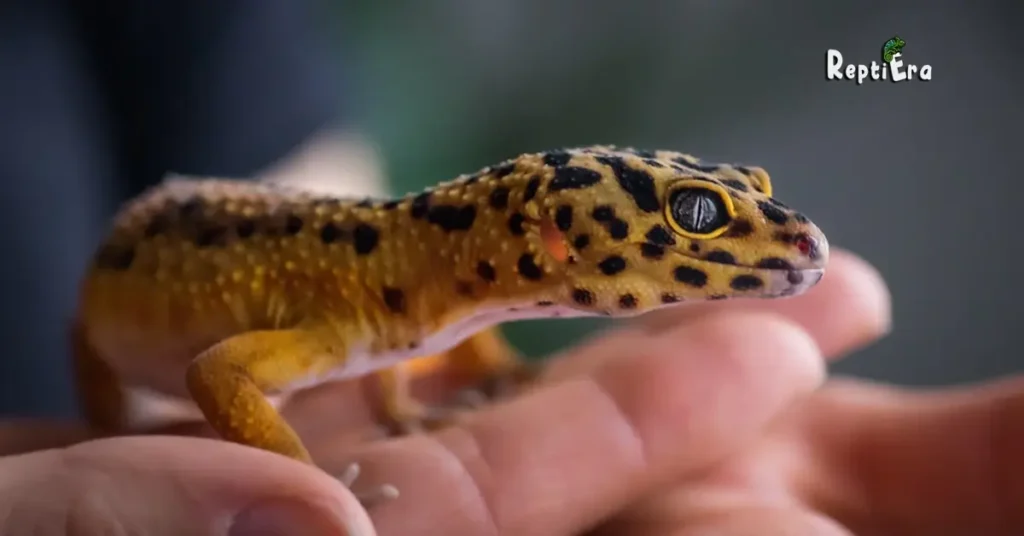
You can gauge successful bonding with your leopard gecko through their curious, active, and expressive behaviour, which is part of their nature as reptiles. When they feel safe, relaxed, and comfortable around you, it’s a positive sign. Notice their actions during feeding time: if your gecko eats from your hand, hunts in your presence, or trusts you enough to not retreat to their hiding spot, these are indicators of interest and trust.
A gecko that comes to greet you when you enter the room or willingly jumps onto your hand or climbs out of their enclosure to explore signifies an ultimate sign of a strong, healthy relationship. If you’ve reached this stage, congratulations – your patience and care have truly paid off in building a bond with your leopard gecko.
Manage Your Expectations
When it comes to the time it takes to build bonds with a leopard gecko, it’s important to manage your expectations. Unlike a dog, often hailed as ‘Man’s Best Friend‘, a gecko may not exhibit the same overt signs of love or recognition. They are not dumb, but rather solitary and asocial by nature.
Expecting them to respond to you the same way a dog would is a lofty goal. However, they can recognize certain sounds and interact with you in their own unique way. With patience and a consistent routine, your gecko might greet you at the front of their enclosure or react to your signature sound, especially around regularly scheduled mealtimes.
Tip: For a leopard gecko, showing interest in these small ways can signify a good enough bond. They might not like to be cuddled like a dog, but their eagerness for crickets can be just as rewarding.
FAQs
How do I interact with my leopard gecko?
Be mindful not to pick up your gecko by their tail and avoid making them feel cornered or threatened to prevent them from running away. If they run from your hand, take a break from trying to pick up and try again later.
Can I bond with my leopard gecko?
Bonds can be formed with your leopard gecko as an owner through consistent handling, regular feeding times, and talking to them, helping them get used to your presence.
How can I make my leopard gecko happy?
Create a comfortable habitat with a temperature gradient of 73-90º F, multiple hide boxes on both the warm side and cool side of the enclosure, and a humid hide with a moistened sponge, sphagnum moss, or vermiculite to aid in skin shedding.
How do you gain a gecko’s trust?
In southeast Michigan, many reptile owners find success in being patient, placing their hand on the other side of the terrarium and letting the gecko inspect it in their own time; rushing or forcing interaction is counterproductive to building a trusting relationship.
What do leopard geckos love the most?
Leopard geckos love and go crazy for bugs and insects, making them easy to feed; however, it’s a fact that they can be overfeeding if you put too much in front of them.
Conclusion
In conclusion, bonding with a leopard gecko involves understanding and catering to their unique preferences and behaviours. These fascinating reptiles have a strong affinity for bugs and insects, which makes feeding them an enjoyable and straightforward task. However, it’s important to be mindful of their dietary needs to avoid overfeeding. Establishing a bond with your leopard gecko is a rewarding experience that requires patience, attentiveness to their habits, and a deep appreciation for their distinctive nature. By respecting their space and learning their likes, particularly their love for bugs, owners can develop a meaningful and lasting relationship with their leopard geckos.

